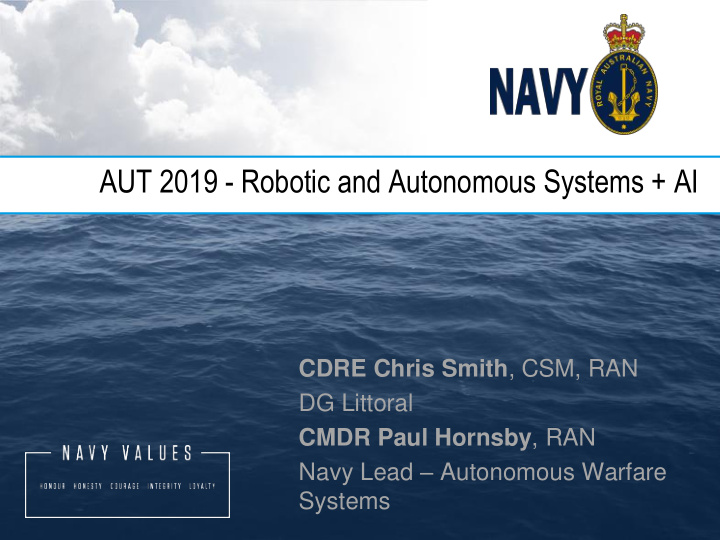



AUT 2019 - Robotic and Autonomous Systems + AI CDRE Chris Smith , CSM, RAN DG Littoral CMDR Paul Hornsby , RAN Navy Lead – Autonomous Warfare Systems
Welcome to…
• Outcomes of AW18, Focus Groups • Trends (and Threats) • Future Strategy & Engagement
Outcomes so far… • AW18 was the first autonomous exercise conducted by western allies involving all domains - air, surface, sub-surface, ground and cyber / AI • 47+ companies, 77 platforms (38 dynamic), 29 under AIM C2
Lessons & Challenges • Achieved world firsts by operating multiple vehicles (in all domains) concurrently on one system / one operator • Informed applicable authorities on future rules • Tested systems in more challenging communications and toughest environmental conditions.
Integration will be critical… • System integration of 22 software components from 14 organisations across all FVEY partners – notably including initial integration of 9LV with UK’s Maritime Autonomous Platform Exploitation (MAPLE). • First Robotic & Autonomous System architecture that digitally integrates multi-domain unmanned systems into C2. • Voice coordination between operators replaced with defined message flows and interface standards, permitting the architecture simultaneous digital control of multiple systems and across all domains.
Trends (& Threats) • Force Multiplier – small teams controlling large unmanned fleet in a (more) dynamic threat environment • Interoperability – C2 architecture to provide guidelines for industry innovation and avoid Defence exposure to IP lock-in • Integration – of FVEY technologies for faster and more informed capability decisions (that saves on national development costs) • Agility – merge of tactical and operational control for faster operational decision cycles – critical to defeat swarms and AI
Future Directions • UUV, USV, XLUUV, MTUAS • Applications already in Surveillance, REA and MCM • Integration into shipboard systems • Greater focus towards AI
9 Mine Counter Measures • The program remains in the acquisition phase and will approach IOC in 2020. • A Deployable Mine Countermeasures (DMCM) capability will detect, classify, and identify sea mines, and where necessary, neutralise in the absence of dedicated mine countermeasures vessels. The capability may be deployed within a Task Group or Task Unit to provide DMCM along intended routes, through choke points, and within objective areas by either neutralising the mines or avoiding them. • Will provide scalability, flexibility and reduced transit times for MCM effects.
1 0 AI The Future of Artificial Intelligence (AI) • Ongoing FVEY development of applications including MAPLE (CMS); Recommender (Anticipate best action); Narrative (Avatar); Authority Pathway (ROE); DARRT (Autonomous T&E); and COMPACT (policy management). Robotic Process Automation (RPA) - RPA technology sits at the ‘simple’ end of the Ai tech spectrum – Navy has developed and implemented an RPA capability for the Defence Protected Network (DPN) and commissioned several ‘Ai Assistants’ or Bots to free up humans from time consuming work, thus creating capacity for humans to do higher value cognitive work. Machine Learning (ML) - Navy has conducted POCs with ML focussed on video analytics, developed to assist with surface gunnery analysis and identification of camouflaged soldiers.
1 1 AI - Applications in Combat Management Systems • AI support to CMS decisions – Continuous development of future combat management systems will enable the rapid fielding of new technologies as they become available including AI applications to support autonomous decision making. – AI provides the potential to transform traditional approaches of problem solving that involve higher levels of cognitive input or benefit from automation. – AI could be used to improve situational awareness and decision- making, safety of operation, predictive maintenance and business processes.
1 2 AI - Applications in Robotic & Autonomous Systems • Context Awareness – Appreciation of the emerging situation through available data and reacting appropriately to execute mission intent. • On-board Payload Analysis – Data analysis on the platform, reducing to relevant and executable information. • Network Independence – Distributed decision making, resilient in DDIL environments. • Trusted Autonomy – Progression from Human-in-the-Loop, to Human-on-the-Loop, to many loops, to orchestration of Autonomous Systems – Autonomous decisions, within the bounds of delegated authority and Rules of Engagement.
Littoral • Problem Statement : How can Navy optimise refresh of RAS/AI technology associated with the MCM and Hydro/Oceanographic capability (SEA 1905/2400) to maintain pace with a rapidly evolving threat and changing technology? • Problem Background : The rapid change in technology associated with RAS/AI systems will result in a range of refresh cycles across various elements of the 1905/2400 capability elements (C2, sensors, classification tools, effectors etc). The ability to upgrade and at times replace elements of the MCM and Hydrographic systems with emerging technologies is essential to remaining abreast of the threat. The optimisation of this refresh rate will require the balancing of fiscal, training and operational risk factors.
Questions?
Recommend
More recommend